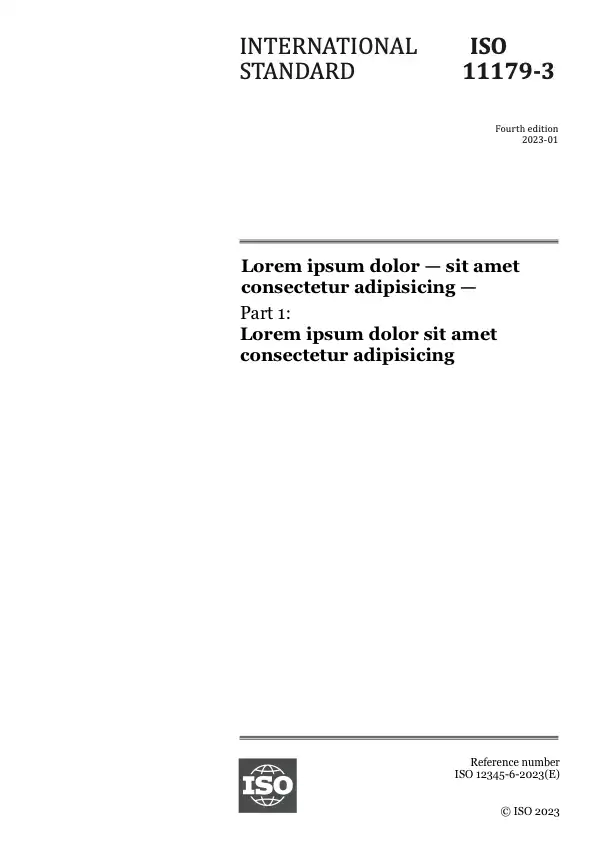Тезис
ISO 11111-1:2016 specifies safety requirements for frequently occurring hazards common to the types of textile machinery and the hazards of certain machine elements covered by ISO 11111‑2 to ISO 11111‑7. The standard series is complemented by the type C standards ISO 9902 (all parts) with respect to noise emission measurement and ISO 23771 with respect to measures for the reduction of noise emissions.
ISO 11111-1:2016 is applicable to machinery plant and related equipment intended to be used in the textile industry for the following purposes:
- opening, cleaning, blending, carding, preparation subsequent to carding, spinning and other processing of fibres (staple and filament) and other materials to form yarn or nonwoven material (including felts);
- winding, doubling, twisting, texturing, etc., of yarns and the processing of yarns preparatory to weaving and knitting;
- weaving, knitting, lace-making and similar utilization of yarn, etc., to form fabric;
- forming of braid, cord, strand, rope, twine, net, etc., except take-up reels of stranding and laying machinery;
- processing, including the pretreatment, bleaching, dyeing, printing and finishing of fibre, yarn, fabric, braid, cord, etc., and final assembly for dispatch;
- piece-dyeing of made-up goods;
- finishing of warp and weft knitting, including hosiery, other than assembly of the finished product (e.g. sewing);
- manufacturing of carpets by weaving, tufting and other processes.
ISO 11111-1:2016 applies to all machinery, plant and equipment used during the processes listed above, including equipment to enable automated operation of the machines and processes in either free-standing or complex installations, such as pneumatic fibre transportation, but excluding other transportation between the interfaces of the machines.
NOTE 1 The standard for a specific textile machine will normally consist of two parts: this part of ISO 11111 and the specific part of ISO 11111 relevant to that machine. However, in the case of nonwoven lines, which are covered by ISO 11111‑3, ISO 11111‑2, ISO 11111‑6 and ISO 11111‑7 are also to be taken into account.
ISO 11111-1:2016 does not deal with specific requirements for pressure containment.
NOTE 2 In the EU and EFTA, specific directives for pressure vessels and electromagnetic compatibility, among others, exist.
ISO 11111 (all parts) addresses hazards arising from the transport, assembly and commissioning of the machinery, its adjustment, use, maintenance, decommissioning, dismantling and disposal. Manual loading/unloading is considered to be part of the normal operation of the machinery.
ISO 11111-1:2016 and the other parts of ISO 11111 are not applicable to machinery, plant and related equipment used for
- manufacturing continuous filaments and man-made fibres up to and including the formation of the first textile package (e.g. continuous filament cheese, staple fibre bale),
- hackling and carding of flax and similar,
- manufacturing of spun-bonded and melt-blown nonwovens,
- forming and making up of garments, household and industrial textile goods, and the pressing and die cutting of nonwoven fabric,
- laundering and dry cleaning of made-up textile goods,
- servicing of textile machines (e.g. machines for card wire mounting, cleaning machines for components of printing machines), and
- certain cutting devices, e.g. log-slitting device, laser cutting, high pressure water jets, ultrasonic device.
NOTE 3 The machines and equipment listed in Annex E are used in the textile industry but are not within the scope of this part of ISO 11111.
ISO 11111-1:2016 and the other parts of ISO 11111 are not applicable to machinery intended for use in potentially explosive atmospheres.
ISO 11111-1:2016 and the other parts of ISO 11111 are not applicable to machines which are manufactured before the dates of publication of the International Standards.
Preview
Общая информация
-
Текущий статус: ОпубликованоДата публикации: 2016-05Этап: Подтверждение действия между-народного стандарта [90.93]
-
Версия: 3
-
Технический комитет :ISO/TC 72/SC 8ICS :59.120.01
- RSS обновления
Жизненный цикл
-
Ранее
ОтозваноISO 11111-1:2009
-
Сейчас
ОпубликованоISO 11111-1:2016
Стандарт, который пересматривается каждые 5 лет
Этап: 90.93 (Подтверждено)-
00
Предварительная стадия
-
10
Стадия, связанная с внесением предложения
-
20
Подготовительная стадия
-
30
Стадия, связанная с подготовкой проекта комитета
-
40
Стадия, связанная с рассмотрением проекта международного стандарта
-
50
Стадия, на которой осуществляется принятие стандарта
-
60
Стадия, на которой осуществляется публикация
-
90
Стадия пересмотра
-
95
Стадия, на которой осуществляется отмена стандарта
-
00
Появились вопросы?
Ознакомьтесь с FAQ
Часы работы:
Понедельник – пятница: 09:00-12:00, 14:00-17:00 (UTC+1)

